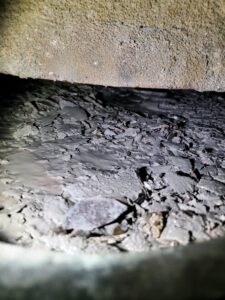Boiler Acid Rinse
Company Experience-
RTA frequently performs the boiler acid rinse to replace the commonly called boiler acid cleaning. The boiler acid rinse is a modification of a full boiler acid clean ( which guarantees 95% to 100% clean). In many applications, it has many advantages to a full acid clean.

Scale on tubes and bottom of boiler
These include the following:
- 1/3 The Price
- 1/3 The Risk
- No Residual Or Disposal Problems
- Results: 50%-80% Clean
Why Use A boiler Acid Rinse?
- With a boiler acid rinse, RTA is able to use less acid, less manpower, and the customers’ cooperation to achieve almost the same results of a complete guaranteed-result acid cleaning.
- Less acid means less stress on the boiler.
- Less RTA manpower means significantly reduced costs.
- A customers’ cooperation means the acid rinse is performed during a boiler tear down, minimizing any extra cleaning time for the customers’ employees.
How Does Boiler Acid Rinse Work?
- RTA gives the customer complete instructions after performing a complete analysis of deposit. See Deposit testing.
- The customer prepares the boiler with injection fittings and vent fittings.
- RTA pumps in the acid and supervises the heating process.
- An RTA representative returns the next day after the customer has rinsed out all boiler sludge.
- The results are mutually evaluated by the customer and the RTA representative.
Tabulation Of Fuel Loss From Scale
| Scale Thickness(in Inches) | Coal Wasted Per Ton Fired(in Pounds) | **Oil Wasted Per 1000 Gallon Burned (in Gallons) | ** Gas Wasted Per 100,000cf Burned (in cubic ft.) | % Fuel Savings |
|---|---|---|---|---|
| 1/32 | 144 | 72 | 7200 | 7.2 |
| 1/25 | 186 | 93 | 9300 | 9.3 |
| 1/20 | 220 | 111 | 11,000 | 11.0 |
| 1/16 | 252 | 126 | 12,600 | 12.6 |
| 1/11 | 300 | 150 | 15,000 | 15.0 |
| 1/9 | 318 | 159 | 15,900 | 15.9 |
| 1/8*** | 328*** | 164*** | 16,400*** | 16.4*** |
*Based on table prepared by United States Bureau of Mines.
** Based the same percentage waste as when burning coal.
***Based extrapolation data
Note- acid cleanings or acid rinses are performed to produce savings in fuel as shown above, as well as protect the safety and integrity of the boiler. See Boiler plant energy savings